
Original Link: https://www.anandtech.com/show/2714
Intel Core 2 Quad Q9550S: A New 65W Quad-Core
by Anand Lal Shimpi on January 27, 2009 8:00 PM EST- Posted in
- CPUs
In one breath Intel dramatically cut pricing on its Core 2 Quads. Intel’s swift response was even faster than NVIDIA’s after the RV770 launch. In the following breath however, Intel introduced new, lower power, and much higher priced Core 2 Quad CPUs. Enter the S-line.
TDP binning is something that AMD has done for quite a while on the desktop. The e-suffix parts (e.g. Phenom X4 9350e) are lower TDP parts, sold at a premium, to those users who need lower power consumption.
The Phenom X4 9350e and the 9150e are both 65W quad-core parts from AMD, while all of Intel’s quad-core CPUs have been 95W. Unwilling to allow AMD any sort of advantage, Intel has finally responded with 65W quad-core offerings of its own. The difference here is that while AMD’s 65W quad-cores are all significantly lower clocked Phenom processors, Intel’s 65W chips are available at up to 2.83GHz.

The Core 2 Quad Q9550S, Q9400S and Q8200S are all 65W TDP quad-core CPUs. They share the same specs as their non-S brethren. The only difference here is that instead of being 95W TDP parts, these CPUs can fit in a 65W thermal envelope.
| Processor | Clock Speed | L2 Cache | L3 Cache | TDP | Price |
| Intel Core i7-965 Extreme Edition | 3.20GHz | 1MB | 8MB | 130W | $999 |
| Intel Core i7-940 | 2.93GHz | 1MB | 8MB | 130W | $562 |
| Intel Core i7-920 | 2.66GHz | 1MB | 8MB | 130W | $284 |
| Intel Core 2 Quad Q9650 | 3.00GHz | 12MB | - | 95W | $316 |
| Intel Core 2 Quad Q9550S | 2.83GHz | 12MB | - | 65W | $369 |
| Intel Core 2 Quad Q9550 | 2.83GHz | 12MB | - | 95W | $266 |
| Intel Core 2 Quad Q9400S | 2.66GHz | 6MB | - | 65W | $320 |
| Intel Core 2 Quad Q9400 | 2.66GHz | 6MB | - | 95W | $213 |
| Intel Core 2 Quad Q8300 | 2.50GHz | 4MB | - | 95W | $183 |
| Intel Core 2 Quad Q8200S | 2.33GHz | 4MB | - | 65W | $245 |
| Intel Core 2 Quad Q8200 | 2.33GHz | 4MB | - | 95W | $163 |
The price premium for these new S-parts is huge. The Q9550S costs $103 more than the non-S, the Q9400S will set you back another $107 and the Q8200S is the most affordable with only an $82 premium. Note that in the case of the Q9550S and Q9400S you're actually more expensive than the entry level Core i7-920.
Intel achieves these lower TDPs by running at a lower core voltage. With a mature enough manufacturing process, which Intel’s 45nm process is, it’s quite possible to produce CPUs that run much cooler than average and on a lower voltage. CPU power varies with the square of the voltage, so any savings in voltage can result in a non-linear decrease in power consumption.
Don’t get too excited however. If you remember back to our review of the 9350e/9150e we found that the decrease in power wasn’t worth the added price. Even Intel has come forward and told us that these are primarily OEM parts and not intended for the high volume enthusiast community. With Intel being honest in its intended purpose for these S-class CPUs we don’t really have to do much to keep them honest, we just need to confirm the findings.
To do this we took a subset of our regular CPU performance tests and looked at performance, power consumption and power efficiency. We measured total system power consumption at the wall outlet, which does admittedly lessen the impact of a lower power CPU but it should give us an idea of the real world benefit of these processors. If you want to see how the Q9550/Q9550S performs across our entire suite of benchmarks take a look at AnandTech bench, our new publicly available benchmark database.
...and in case you’re wondering, no, they don’t overclock any better. Our Q9550S couldn’t get any further than the Q9550 we used in our Phenom II review.
The Test
| CPU: | AMD Phenom II X4 940 (3.0GHz) AMD Phenom 9950 (2.6GHz) Intel Core i7-965 (3.2GHz) Intel Core i7-920 (2.66GHz) Intel Core 2 Extreme QX9770 (3.2GHz/1600MHz) Intel Core 2 Quad Q9650 (3.00GHz) Intel Core 2 Quad Q9550S (2.83GHz) Intel Core 2 Quad Q9450 (2.66GHz) Intel Core 2 Quad Q9400 (2.66GHz) |
| Motherboard: | Intel DX58SO (Intel X58) Intel DX48BT2 (Intel X48) MSI DKA790GX Platinum (AMD 790GX) |
| Chipset: | Intel X48 Intel X58 AMD 790GX |
| Chipset Drivers: | Intel 9.1.1.1010 (Intel) AMD Catalyst 8.12 |
| Hard Disk: | Intel X25-M SSD (80GB) |
| Memory: | G.Skill DDR2-800 2 x 2GB (4-4-4-12) G.Skill DDR2-1066 2 x 2GB (5-5-5-15) Qimonda DDR3-1066 4 x 1GB (7-7-7-20) |
| Video Card: | eVGA GeForce GTX 280 |
| Video Drivers: | NVIDIA ForceWare 180.43 (Vista64) |
| Desktop Resolution: | 1920 x 1200 |
| OS: | Windows Vista Ultimate 64-bit |
Adobe Photoshop CS4 Performance
To measure performance under Photoshop CS4 we turn to the Retouch Artists’ Speed Test. The test does basic photo editing; there are a couple of color space conversions, many layer creations, color curve adjustment, image and canvas size adjustment, unsharp mask, and finally a gaussian blur performed on the entire image.
The whole process is timed and thanks to the use of Intel's X25-M SSD as our test bed hard drive, performance is far more predictable than back when we used to test on mechanical disks.
Time is reported in seconds and the lower numbers mean better performance. The test is multithreaded and can hit all four cores in a quad-core machine.
Before we get to performance let's look at idle power consumption:
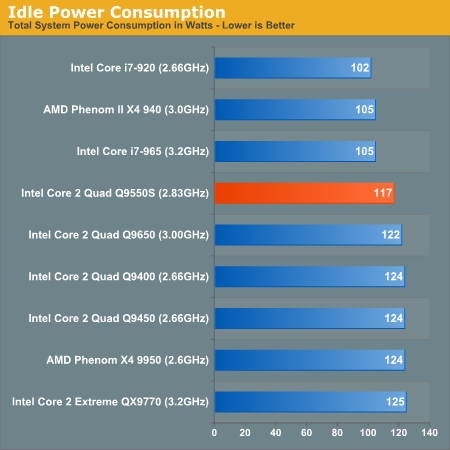
Now let’s look at performance:
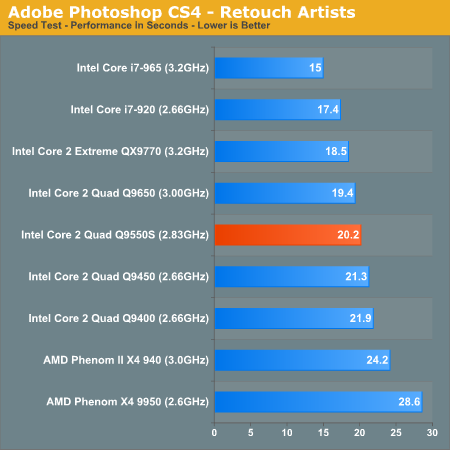
The best performers in this benchmark, by far, are the Core i7 processors. If you’re building the ultimate Photoshop machine, Core i7 is what you want. The entry level Core i7-920 is faster than the Core 2 Extreme QX9770, despite the latter being priced at over $1000.
Note that the Core 2 Quad Q9550S performs identically to a Core 2 Quad Q9500; right in between a Q9650 and a Q9450, just as you’d expect.
Next we measured the average power consumption of the entire machine during the Photoshop benchmark, the results are reported in watts. Lower numbers are better here:
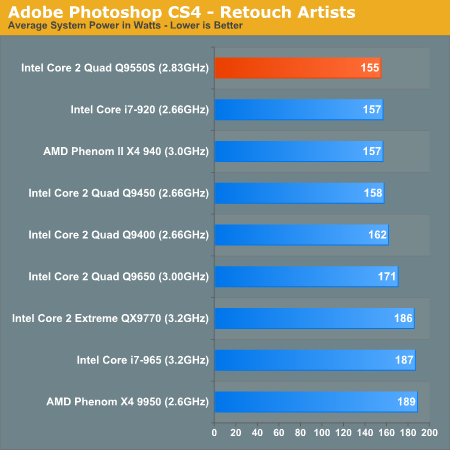
Now we see the benefit of the new -S parts; the Core 2 Quad Q9550S draws less power than any other chip we tested, including the much smaller, cooler running Q9400. While the Q9550S still uses the original 820M transistor Penryn core, the Q9400 is a smaller 456M transistor part.
While we don’t have a real Q9550 to compare to, if you look at the power consumption of the Q9650 and the Q9450 you can estimate that a Q9550 would be somewhere in between - perhaps around 165W. That would put the average energy savings of the 9550S at 10W.
We can also look at the maximum power consumed during the course of the test:
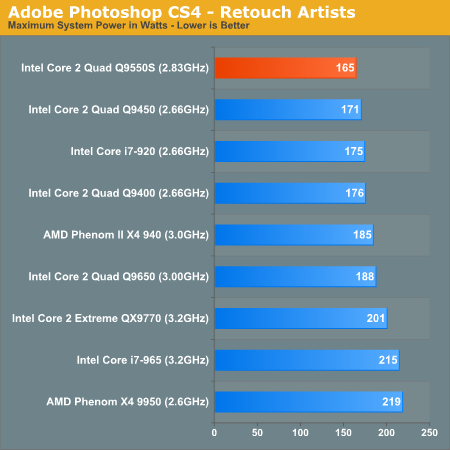
The Q9550S’ advantage amounts to around 15W under peak power draw.
Efficiency is equally important, here we’re looking at total energy consumed by the system over the life of the test. Energy consumed takes into account how long the test takes to complete, which will be shorter on faster machines.
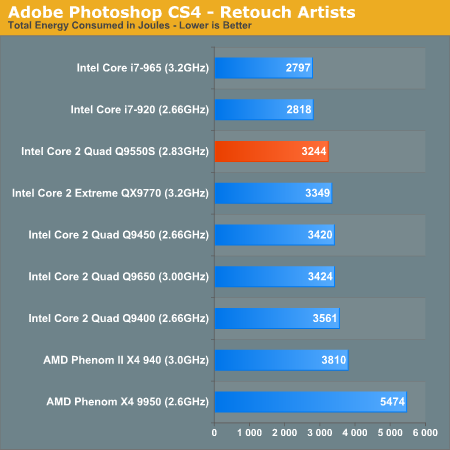
Here the Q9550S is marginally better than its Penryn siblings. There’s about a 5% drop in total energy consumed compared to a Q9650. And this is where the argument for energy efficiency falls short with the Q9550S; look at the total energy consumed on the Core i7, it blows the Q9550S out of the water.
While the Core i7-920 draws as much as 6% more power than the Q9550S, it also completes the benchmark in nearly 14% less time. If you want the best performance per watt, skip the Core 2 Quad Q9550S and buy the Core i7-920.
x264 HD Video Encoding Performance
Graysky's x264 HD test uses the publicly available x264 codec (open source alternative to H.264) to encode a 4Mbps 720p MPEG-2 source. The focus here is on quality rather than speed, thus the benchmark uses a 2-pass encode and reports the average frame rate in each pass.
I measured power and performance in the second pass of the benchmark since that’s where the more CPU intensive work gets done.
First, we look at performance:

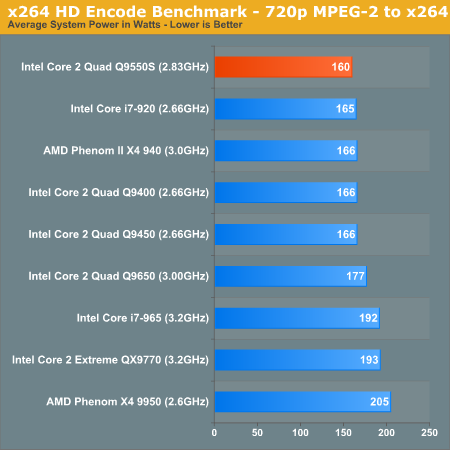
The Q9550S takes the cake with the lowest average power during the x264 encode, even slightly lower than the Q9400.
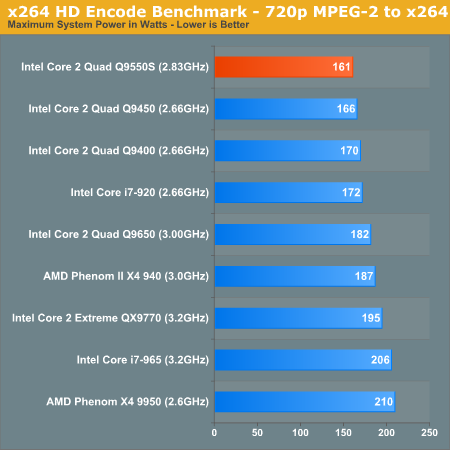
Peak power is also lowest on the Q9550S, note that it draws 11W less than the Core i7-920. But the thing to keep in mind is that, once more, the i7-920 is about 40% faster than the Q9550S.
Let’s look at the total energy consumed by the system during the benchmark:

Once again, the two Core i7 platforms offer better energy efficiency than the new Q9550S. In fact, the Q9550S offers about the same energy efficiency as the rest of the Core 2 Quad lineup and AMD’s new Phenom II X4 940. If you want energy efficiency, you actually want a Core i7.
POV-Ray 3.73 beta 23 Ray Tracing Performance
POV-Ray is a popular, open-source raytracing application that also doubles as a great tool to measure CPU floating point performance.
I ran the SMP benchmark in beta 23 of POV-Ray 3.73. The numbers reported are the final score in pixels per second.
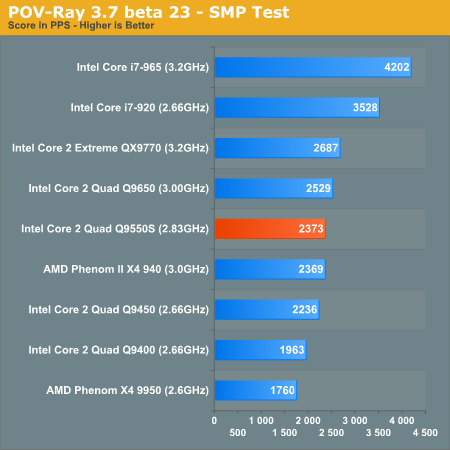
Performance under POV-Ray shouldn’t be a surprise to anyone who’s been following the last few CPU articles here at AnandTech. The Core i7 dominates while the Phenom II is quite competitive with the quad-core Penryns. Let’s look at average power consumption:

On average, the Q9550S pulls 10 fewer watts than the Core 2 Quad Q9400, despite being 21% faster. Compared to the Q9650 the difference grows to 25W.
Peak power consumption is similarly svelte for the Q9550, we’re talking 161W at most for the entire system:
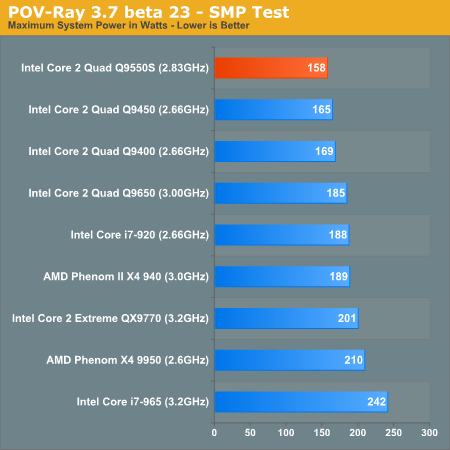
As impressive as the power numbers are however, once again we see that total energy consumed is actually lower on the Core i7 systems - by a lot.

The Core 2 Quad Q9550S used 17216J of energy during the POV-Ray test while the Core i7-920 used only 13876 joules. If you want a lower power bill, go for the i7.
PAR2 Multithreaded Archive Recovery Performance
Par2 is an application used for reconstructing downloaded archives. It can generate parity data from a given archive and later use it to recover the archive
Chuchusoft took the source code of par2cmdline 0.4 and parallelized it using Intel’s Threading Building Blocks 2.1. The result is a version of par2cmdline that can spawn multiple threads to repair par2 archives. For this test we took a 708MB archive, corrupted nearly 60MB of it, and used the multithreaded par2cmdline to recover it. The scores reported are the repair and recover time in seconds.

The multithreaded nature of this benchmark favors the Core i7 systems since they can work on more threads at the same time.
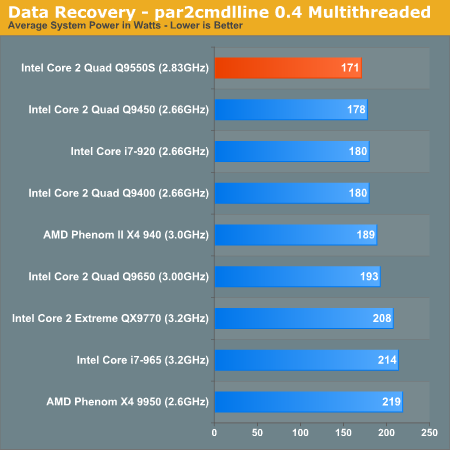
The Q9550S continues to hold the average power advantage.
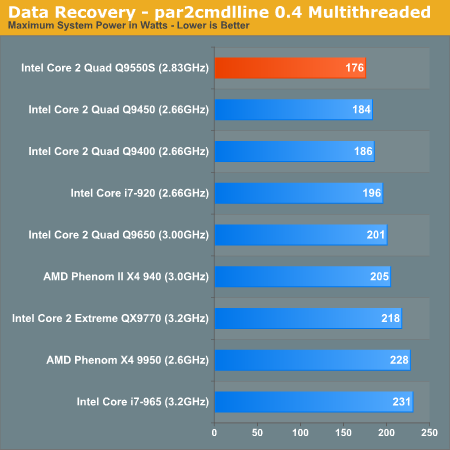
And it's the lowest power quad-core here when we look at peak power consumption as well.
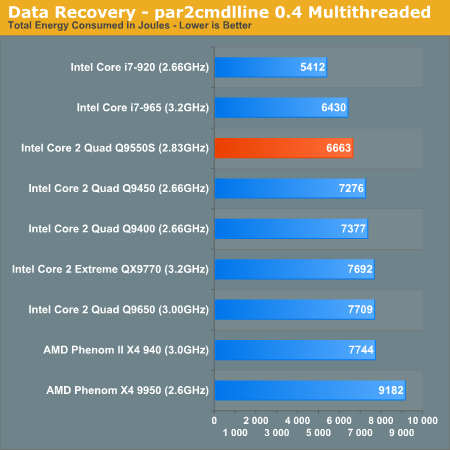
While the Q9550S is the most energy efficient of the quad-core Penryn based processors, the Core i7-920 is still more desirable from a performance per watt standpoint.
Fallout 3 Game Performance
Bethesda’s latest game uses an updated version of the Gamebryo engine (Oblivion). This benchmark takes place immediately outside Vault 101. The character walks away from the vault through the Springvale ruins. The benchmark is measured manually using FRAPS.

Gaming performance here is pretty well clustered around the mid 80s.
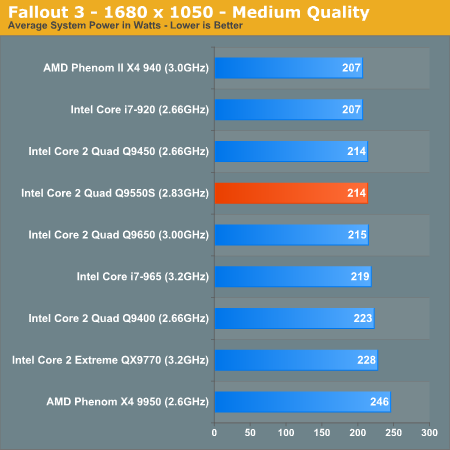
With the GPU being the big driver of power consumption here, the CPUs themselves all use a similar amount of power. The variance between similarly clocked CPUs is normal between runs.
Peak power tells a similar story:
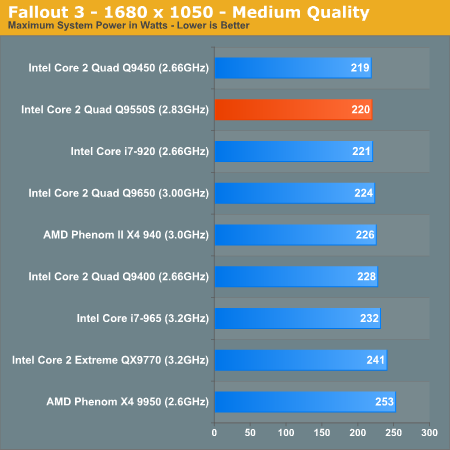
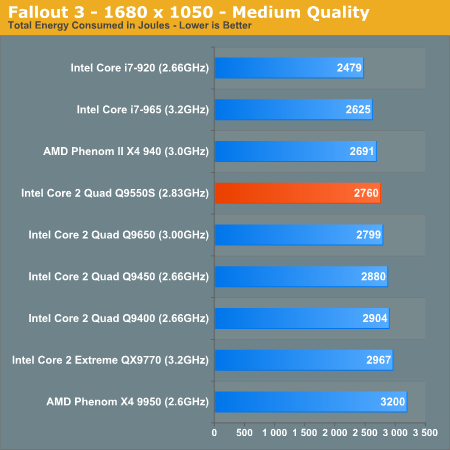
The energy efficiency graph is, however, unexpected. The Fallout 3 benchmark is a fixed time test; in other words, it takes the same amount of time to complete regardless of the system. With all benchmarks taking the same amount of time, total energy consumed should be dependent solely on average power. We’ve already seen that average power is pretty similar between the systems, so we should see some pretty even results here right?
Wrong.
While all of the Core 2 Quads consumed around 2800 - 2900J of energy the Core i7s used 2625J and 2479J for the 965 and 920, respectively. Remember that a feature of Core i7 is the ability to completely cut power to one of the cores if it’s not being used. This feature is thanks to Intel’s power gate transistors, which aren’t used in the Core 2 Quads. In a game where all four cores aren’t taxed, Core i7 can pull ahead in energy efficiency despite using a similar amount of power to the rest of the contenders.
The i7-920 actually uses less energy in this test than the lowest power quad-core Penryn we have on the chart.
FarCry 2 Multithreaded Game Performance
FarCry 2 ships with the most impressive benchmark tool we’ve ever seen in a PC game. Part of this is due to the fact that Ubisoft actually tapped a number of hardware sites (AnandTech included) from around the world to aid in the planning for the benchmark.
For our purposes we ran the CPU benchmark included in the latest patch:
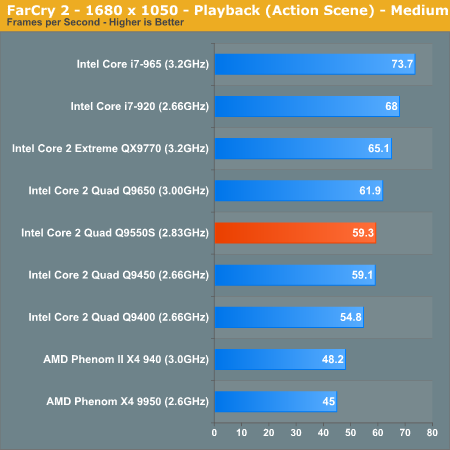
Power consumption is a bit more spread out thanks to this being more of a CPU test. The Q9550S continues to have the lowest average and peak power draw of any of the quad-core CPUs we’re looking at here today.
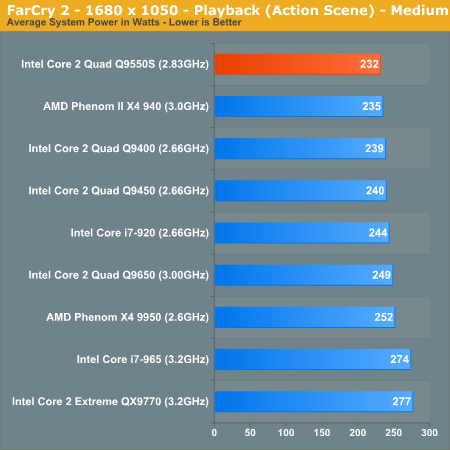
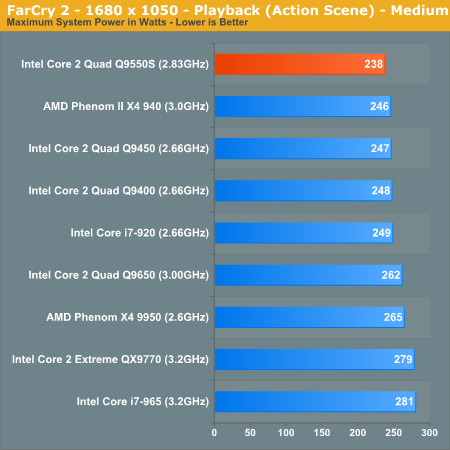
Energy efficiency is back to normal here as well; the test doesn’t run for a fixed time, it runs as quickly as it can. While this isn’t a realistic gaming scenario (just because you have a faster CPU it doesn’t mean you run any faster), it is useful for looking at how efficiently these CPUs handle the sort of code thrown at them by modern day game engines.
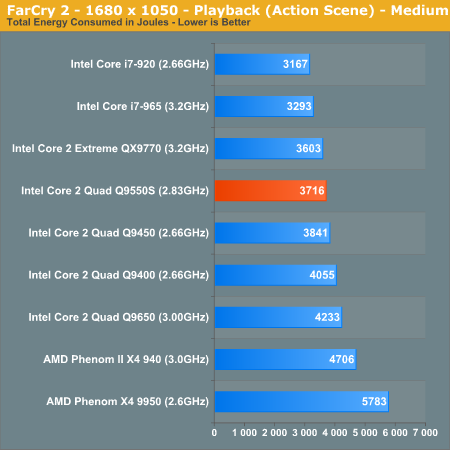
Despite the decrease in power consumption, it’s just not enough to make the Q9550S actually any more energy efficient. It’s a cooler running part, but the performance per watt ratio of the Core i7 remains untouched.
Final Words: So Who Should Buy This Thing?
Over the past few pages of performance, power and efficiency graphs we’ve proved that the Q9550S offers lower power, but also lower efficiency than other Intel CPUs. In particular, the Core i7 is a far more power efficient processor thanks to its significant performance advantage. Then why on earth would anyone ever consider the Q9550S or any of the other new 65W parts for that matter?
The answer lies in the thermals. I took a few of the chips and used CoreTemp64 to record temperature data while running Prime95. I ran Prime95 for 10 minutes and averaged the temperatures of all four cores.
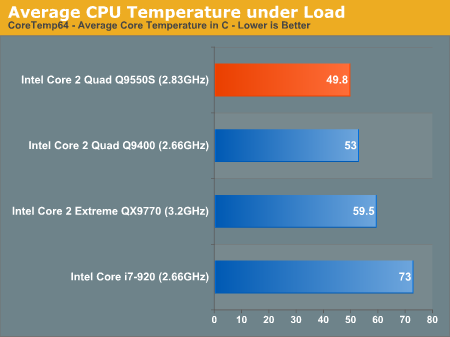
Remember the Core i7-920 that’s got such better power efficiency than the Q9550S? Well that doesn’t really matter if the CPU puts out too much heat. The i7-920’s cores got up to around 73C, the QX9770’s cores managed just under 60C while the Q9550S ran at a “cool” 49.8C.
For most users this doesn’t matter, the Core i7-920 would spend more time at idle (31.3C) than the Q9550S since it can complete tasks faster. Where this does matter however is if you’re running in a thermally constrained environment; for example, an all-in-one PC.
The Q9550S and the other 65W quad-cores are designed for OEMs or anyone trying to cram as much power into a very small space. I’d expect that these CPUs would be better suited for something like an iMac rather than a normal sized desktop. The problem is that in a normal desktop you’ve got more than enough room to keep even a Core i7 cool, but in some of these OEM designs (like the iMac or Dell XPS One 24) there’s hardly enough room for a normal heatsink and fan.
The S-series looks like it’s designed to allow OEMs to offer higher clocked quad-core CPUs in smaller form factors. If you’ve got a normal sized case however, there’s no reason to pay the price premium for one of these processors. If you do care about energy efficiency, you’d be much better off spending the extra $100 on a Core i7 system instead.







